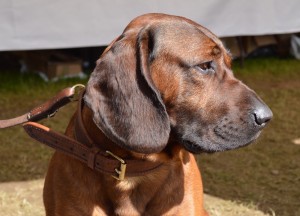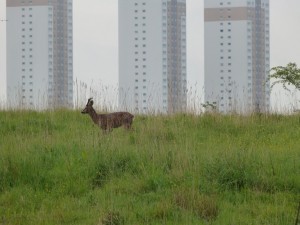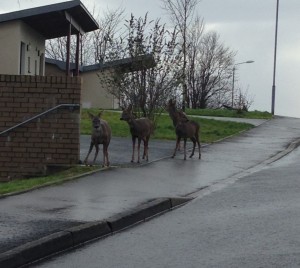In April, the Environment, Climate Change and Land Reform Committee of the Scottish Parliament published its report on deer management in Scotland. This followed its evidence -taking sessions on the 2016 Scottish Natural Heritage report on the same subject. This report goes to the Cabinet Secretary for the Environment, Roseanna Cunningham MSP. Having assessed its content she will then respond for the Government. The Committee’s full report can be accessed here or by using the link in the right hand menu.
Review of Deer Management in Scotland
Deer Management in Scotland: Report to the Scottish Government from Scottish Natural Heritage (2016)
ECCLR Committee – final evidence session of the Deer Management Review
The Environment, Climate Change and Land Reform (ECCLR) Committee of the Scottish Parliament has been undertaking a review of deer management and held its final evidence session on 24 January 2017.
You can watch the video record of this and the previous ECCLR Committee evidence sessions on Scottish Parliament TV here . The draft written report of that final evidence session is available here .
We now awaits the Committee’s findings, its report to the Cabinet Secretary and her proposals and any subsequent actions to be taken by the Scottish Government.
LDNS oral evidence on the Report
LDNS gave evidence to the Scottish Parliament’s Environment, Climate Change and Land Reform (ECCLR) Committee on 13 December 2016. The Scottish Parliament video of that evidence session is available here .
The LDNS written briefing for the Committee is available here .
Native woodlands inside and outside the main red deer range in Scotland
Victor Clements, independent native woodlands consultant based in Perthshire, and also a member of the Executive Committee of ADMG, reassesses the Native Woodlands Scotland Survey and finds that the survey’s conclusions may be distorted. His findings have been published in an extensive report in the winter 2016 issue of Scottish Forestry.
He writes:
The Native Woodland Survey of Scotland (NWSS) published in 2014 gave an up to date account of the status of native woodland areas throughout the country. At the time, the headline message was that herbivore impacts were the greatest threat to these woodlands, and red deer numbers in particular needed to be addressed. Since then, the ongoing deer management planning process has shown that the herbivore impacts in many deer management group areas are actually relatively low, and provisional analysis by Scottish Natural Heritage (SNH) has also shown this to be the case at a national level as well as within much of the main deer range. There are of course exceptions to this.
This paper analyses herbivore impacts within the recognised red deer range in Scotland and compares them with the rest of the country. It also looks at the other issues which result in ‘unsatisfactory’ condition, namely invasive species, non-native tree species, and poor canopy cover, in order to place herbivore impacts in a wider overall context.
The full article can be seen here
Deer management in Scotland: Report to the Scottish Government from Scottish Natural Heritage 2016
LDNS gave evidence to the Scottish Parliament’s Environment, Climate Change and Land Reform (ECCLR) Committee on Tuesday 13 December on the SNH Report on deer management published in November. The LDNS written briefing to the Committee is available here. The video archive of the ECCLR Committee evidence session is available here.
LDNS supporting UK Scent Hound Association (UKSHA) – forthcoming events in Scotland
The UKSHA is staging two events in Scotland supported by the Lowland Deer Network Scotland (including SNH, Forestry Commission Scotland and Transport Scotland), the British Deer Society, the KBGS e.V, the Verein Hirschmann e.V and the ISHV.
Two very experienced judges, one from KBGS and the other from the Verein Hirschmann, both ISHV qualified members of the groups who train people in Germany, and also on the Committee of the clubs in Germany, are coming to Scotland.
Check out German Kälberer and Joachim Schweizer on the Schweißhundestation Alb-Schurwald website. They will be conducting the seminars – both these men are experts with real time experience in training people and dogs to track wounded animals.
Event 1 – Friday 30 September 19.00 – 21.00hrs
County Hotel, Dalkeith EH22 1AY
This seminar will cover:
- The psychology of dogs; learned behaviour based on the genetic disposition of a dog
- The requirements of both sire and dam before breeding
- How to breed and raise healthy, strong minded, efficient and capable hunting-dogs for training and work with wild boar, red deer, sika deer, fallow and roe deer.
- Question and discussion session.
Event 2 – Sunday 2 October
Semeil Farm, Strathdon, Aberdeenshire AB36 8XJ
Shot site seminar
- 0930 – 1030 Theory part 1
- 1030 – 1045 Coffee break
- 1045 – 1200 Theory part 2
- 1200 – 1300 Lunch (please bring your own lunch)
- 1300 – 1630 Practical
This seminar gives the theory required and also demonstrates the practical side of the shot site; how to determine what to do after the shot – and what not to do.
It is hoped that these events will generate more interest in this aspect of deer and boar welfare.
Cost for both events is FREE – as is the tracking of wounded animals undertaken by UKSHA.
Further information and to reserve places by e mail as below:
George Ritchie
Banff & Buchan Deer Group
E: ritchie929@btinternet.com
Mark Telfer
East Lothian and Edinburgh Deer Group
E: markgtelfer@btinternet.com
Urban deer photography competition
Deer farming gathers momentum as retail sales of venison quadruple
In the UK last year (12 months to end June 2014), retail sales of venison increased by over 400% according to Kantar Worldpanel, and that doesn’t take into account what is sold directly by butchers, the restaurant, hotel and catering trade, farmers markets, ‘farm gate’ and mail order sales. To cope with this ever-increasing demand, UK suppliers are importing venison from New Zealand, Poland, Ireland and Spain and industry experts say that the UK is losing out on a lucrative market. In 2013 the equivalent of 29,000 carcases or around 1300 tonnes were imported to the UK from New Zealand alone. But over the last year the Scottish venison market has been limbering up to meet the challenge.
As a result of a campaign to promote the many benefits of venison as a healthy, nutritious and delicious food, and create awareness for the need for more deer farms to cope with demand, over the last six months 200 the first four deer farm demonstration days have seen attendance totalling over 200.
In the last 18 months 80 genuine enquiries about diversification into deer farming have been made to the Venison Advisory Service (VAS), 32 visits to assess potential deer farms at sites all over Scotland have been undertaken by VAS, and 16 detailed studies have been carried out. To date work has already started on six new deer farm units, with a total planned capacity of 2500 hinds. Once on stream these six alone could effectively more than double the current Scottish farmed venison output of 50 tonnes per annum, although in order to meet demand for Scottish breeding stock it is likely that the majority of hinds will be retained while only the stags will go for slaughter.
The objective of the Scottish Venison Partnership, endorsed by the Scottish Government, is to be producing an additional 1000 tonnes of farmed venison per annum by 2020. And it’s not only the farms which will capitalise on a growing demand, but also fencing companies, feed manufacturers, processors etc. This autumn a new dedicated slaughter facility will open in Fife specifically to service the expanding farmed deer sector with a capacity of 100 deer per week.
Spokesperson for the deer and venison industry in Scotland Dick Playfair says:
“It is satisfying to see that there is now some movement in terms of growth. While the issue of Single Farm Payment is resolved in terms of support it will be helpful to know what is in the new SRDP (Scottish Rural Development Programme) that will be of benefit to Scotland’s deer farmers, or not.
“The target for new deer farms we believe is realistic, and not as great in number as we previously thought – indeed if Scotland can achieve 100 new farms with a capacity averaging 250 hinds these could produce in the region of 750 tonnes of venison per annum and give Scotland a really firm grounding in the farmed deer sector.”
During a venison feast lunch at Ballathie Country House Hotel in Perthshire on 28 August media guests were given the opportunity to hear about highland and lowland deer management (including a few words from Ballathie’s own gamekeeper who looks after stalking on the estate), the latest on deer farms, venison industry news and also to experience for themselves the culinary and tasty benefits of venison, thanks to special dishes created by Ballathie chef Scott Scorer.
“We are delighted to have been involved with Eat Scottish Venison Day and to have hosted this lunch as part of the celebrations” says hotel manager Jody Marshall. “Stalking on the Ballathie Estate is popular with our guests and venison is naturally a favourite on our menu. We are fortunate that our head chef enjoys creating interesting venison dishes, making good use of the local Ballathie larder on his doorstep”. Ballathie is featuring venison on the menu for the next fortnight to help celebrate Eat Scottish Venison Day.
Eat Scottish Venison Day is on 4th September and many restaurants, butchers and retailers are putting on special offers and dishes to mark the occasion, including Campbell’s Prime Meat Ltd offering 20% off all venison products during the month of September, Loch Fyne Oyster Bar hosting a special venison BBQ from 12noon to 4pm on the day and Ballathie House Hotel will be featuring venison strongly on the menu for the week.
Visit www.scottish-venison.info for more information about this iconic Scottish product.
Response from Richard Cooke – Effective Deer Management
In response to the recommendations to the Minister for Environment and Climate Change from the Scottish Parliament Rural Affairs and Climate Change Committee, and following its inquiry into deer management and the environment In Autumn last year, Richard Cooke, Chairman of the LDNS and the ADMG said:
“We are encouraged by the recommendations from the Committee to the Minister, and there is much in this report with which we agree, for example that the impacts of deer rather than numbers are most important, and that it is premature to undertake a review of the Code of Practice on Deer Management at this time.
“We also agree with the recommendation that the voluntary deer management system must become more effective in terms of deer management planning, transparency and accountability.
“Whilst there are many Deer Management Groups (DMGs) that are exemplary in what they do there are a number that, for one reason are another, do not attain the required level of performance.We know that there has to be improvement in certain quarters and, even before the inquiry began last Autumn, we had actively begun the process to effect this.
“We have plans to bring those Groups that are not performing up to speed, to improve commitment to and delivery of deer management plans and to ensure that DMGs are more transparent and their communications enhanced where necessary. We have a major initiative being finalised now that will be launched for consultation at our AGM on 20 February, and this will lead to appropriate steps to be taken where required.
“We note the timeframe as laid down in the report for all DMGs to have deer management plans in place by end 2016. This fits with our own thinking and we believe is a realistic deadline.
“Overall, and as said at the time, we consider the RACCE Committee inquiry to have been fair and even-handed. This outcome is evidence of that, and provides us with a range of areas going forward where we can demonstrate improvement. We will continue to work with Government and its Agencies to show that the voluntary system, with their appropriate support, can be entrusted to deliver.”
Ends
First detailed map of Scotland’s native woodlands – FCS launch
Richard Cooke, Chairman of both the Association of Deer Management Groups and the Lowland Deer Network Scotland said:
“This new piece of work, which we have not yet had time to study, will be extremely helpful in focusing deer management on areas where there are specific issues in relation to deer and native woodlands.
“We do believe however that there has been a significant turnaround in the last 30 years in the impacts of deer on native woodland and it is too easy to blame deer at every turn when other factors, for example grazing from other herbivores and now widespread tree disease, are also taking their toll.
“Forestry Commission Scotland (FCS) is a major participant in the deer management sector in Scotland both across the upland red deer range and in low ground areas where considerable new planting is being undertaken. Let’s not forget that deer are also an asset, and that a balance must be struck taking into account environmental, economic and social factors.
“The conclusion we draw is that effective deer management planning is vital particularly at the early stages of any planting or regeneration programme in order to reduce impacts, and making use of all available tools, including fencing. That is nothing new.”
From the deer management perspective it is all too easy to focus on the negatives – there is much on the positive side that we can draw from this new dataset also.
Protecting Scotland’s deer from CWD
Everyone involved in any way with deer, wild or farmed, should be aware of the threat of CWD and what can be done to ensure that this disease does not reach the UK. This is important information – please read.


